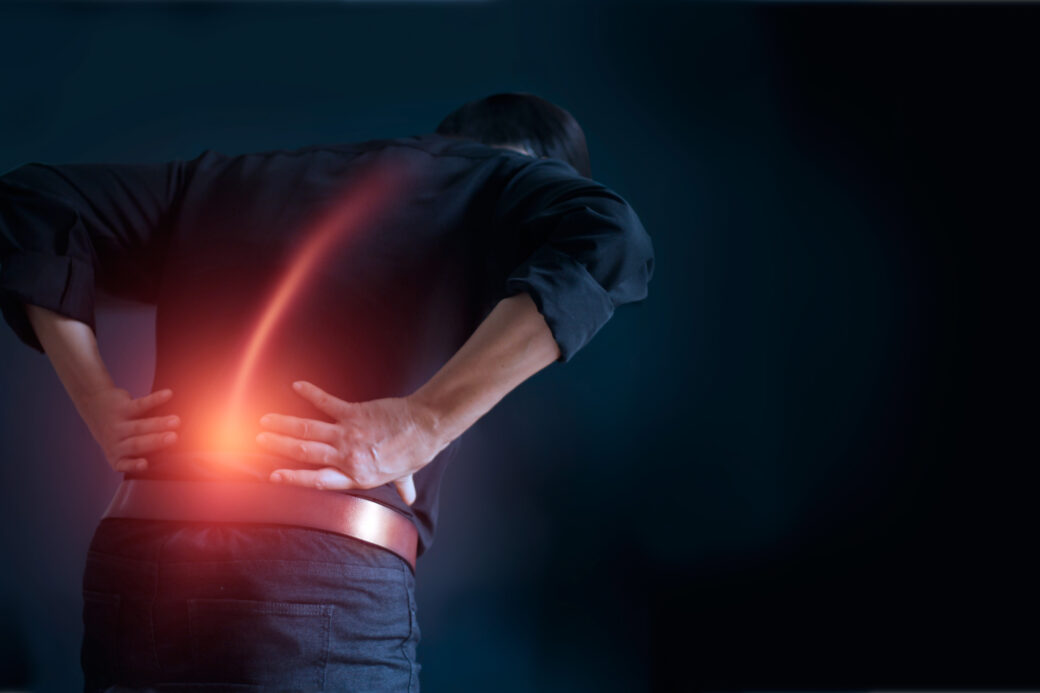
Lower back pain just above the buttocks, often referred to as sacroiliac joint (SI joint) pain or sacroiliitis, can be caused by several factors…
- Sacroiliac Joint Dysfunction – The sacroiliac joints connect the sacrum (triangular bone at the base of the spine) to the pelvis. Dysfunction or inflammation in these joints due to injury, arthritis, pregnancy-related changes, or degenerative conditions can lead to localized pain in the lower back, buttocks, and sometimes radiating down the legs.
- Muscle Imbalances or Strain – Strain or tension in the muscles surrounding the SI joint, such as the gluteal muscles, piriformis muscle, or muscles of the lower back (lumbar paraspinal muscles), can cause pain just above the buttocks.
- Sciatica – Compression or irritation of the sciatic nerve, which runs from the lower back down the back of each leg, can cause pain that radiates from the lower back through the buttocks and into the leg. This condition is known as sciatica and can be caused by herniated discs, spinal stenosis, or degenerative disc disease.
- Degenerative Disc Disease – Wear and tear of the discs between the vertebrae in the lower back can lead to pain and stiffness, particularly in the morning or after prolonged sitting or standing.
- Trauma or Injury – A fall, sports injury, or sudden twisting motion can strain the muscles or ligaments in the lower back, causing pain near the buttocks.
- Ankylosing Spondylitis – This is a type of inflammatory arthritis that primarily affects the spine and sacroiliac joints, causing stiffness and pain in the lower back and buttocks, often worse in the morning or after periods of inactivity.
- Piriformis Syndrome – Irritation or compression of the piriformis muscle, which runs from the sacrum across the buttocks to the top of the thigh bone (femur), can cause pain in the lower back and buttocks region. This can occur due to overuse, trauma, or pressure on the muscle from nearby structures.
Diagnosis and Treatment
- Medical Evaluation – If you experience persistent or severe lower back pain above the buttocks, it’s important to consult with a healthcare professional for an accurate diagnosis. They may perform physical exams, imaging tests (X-rays, MRI), and possibly injections to determine the cause of your pain.
- Treatment Options – Treatment will depend on the underlying cause but may include:
- Rest and Activity Modification – Avoiding activities that exacerbate pain and modifying daily activities to reduce strain on the lower back.
- Medications –Nonsteroidal anti-inflammatory drugs (NSAIDs), muscle relaxants, or pain relievers may be prescribed to alleviate pain and inflammation.
- Physical Therapy – Targeted exercises to strengthen the core muscles, improve flexibility, and stabilize the SI joint or lower back.
- Injections – Corticosteroid injections into the SI joint or surrounding muscles to reduce inflammation and alleviate pain.
- Surgery – In rare cases where conservative treatments are ineffective, surgery may be considered to stabilize the SI joint or address structural issues causing pain.
Managing lower back pain above the buttocks often involves a multidisciplinary approach, including medical intervention, physical therapy, and lifestyle modifications. Early diagnosis and appropriate treatment can help alleviate symptoms and improve quality of life.
Related Posts
Does Walking Strengthen Lumbar Muscles?
On
September 14, 2024
How Long Does It Take For A Lumbar Back Strain To Heal?
On
February 26, 2025
What Does a Slipped Disc Feel Like in Lower Back?
On
July 26, 2022
How Should I Sit To Avoid Lumbar Pain?
On
August 21, 2024



